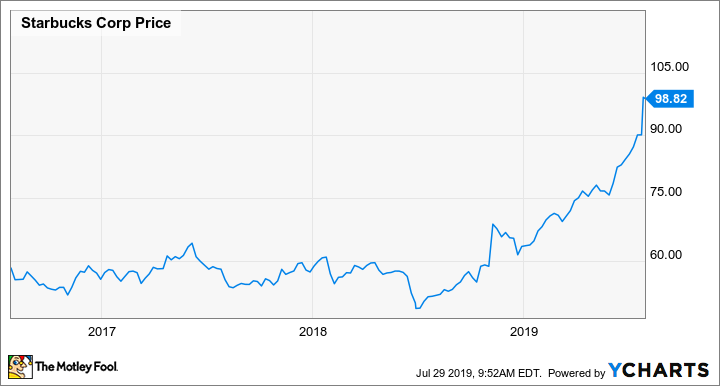It's hard to believe that just a year ago, Starbucks (SBUX 0.29%) stock was down in the dumps. Comparable-sales growth slowed dramatically in the third quarter of the company's 2018 fiscal year, both in the U.S. and in China. This led many investors to sell the stock in a panic, fearing that slower growth was the new normal for Starbucks.
It didn't take long for Starbucks to start proving the bears wrong, as growth rebounded quickly beginning last summer. As a result, the stock surged 60% from a multiyear low below $50 last June to around $78 following the company's Q2 earnings report three months ago. At that time, I argued that the stock had gotten too expensive to be worth holding.
Starbucks stock performance, data by YCharts.
Boy, was I wrong. Shares of Starbucks have continued flying higher over the past three months. Following the coffee giant's strong earnings report last Thursday, the stock jumped another 9% on Friday, reaching a new all-time high close to the $100 mark.
A look back at the slowdown
There were two main reasons for the sharp sell-off in Starbucks stock last June. First, a racial bias incident at a location in Philadelphia in April 2018 led to backlash against the company. It also caused Starbucks to delay some marketing efforts. The result was that comparable-store sales rose just 1% in the U.S. in Q3 of fiscal 2018 (the three-month period ending last June).
Even more troubling to many investors was an abrupt slowdown in Starbucks' growth in China. Comp sales fell 2% in the third quarter of fiscal 2018, due to a government crackdown on third-party delivery services that had been driving lots of growth for Starbucks in the Middle Kingdom.
At the time, I told investors not to panic about the sharp decline in Starbucks stock, arguing that the coffee purveyor had some big growth drivers that would soon come online. I was right about Starbucks' comeback potential -- but failed to realize how much its growth could accelerate.

It didn't take long for Starbucks to return to growth following a blip last year. Image source: Starbucks.
Starbucks is back
Over the past several quarters, Starbucks has improved its sales trajectory around the world. Comp sales rose 3% in the fourth quarter of fiscal 2018, including a solid 4% increase in the U.S. and a return to growth in China. Sales trends accelerated slightly from that level in the first half of fiscal 2019.
In the third quarter, sales trends improved again. Comparable-store sales rose 6%, driven by a 7% comp-sales gain in the U.S. and 6% growth in China. Starbucks also expanded its store count in China by 16% over the past year, adding to its sales growth there. These strong sales trends caused adjusted earnings per share to jump 26% to $0.78, cruising past the average analyst estimate of $0.72.
Starbucks raised its full-year forecast on the back of these strong results. It now expects global comp-sales growth of about 4% in fiscal 2019, along with adjusted EPS between $2.80 and $2.82. For comparison, its initial guidance for the fiscal year called for comp-sales growth closer to 3%, and adjusted EPS between $2.61 and $2.66.
Is Starbucks stock too expensive now?
Because I thought in late April that the stock had come too far, too fast, I (and anyone who followed my lead) missed out on big gains over the past three months. Starbucks' key growth initiatives -- the rollout of delivery services in China and driving mobile engagement in the U.S. -- are paying off, allowing it to beat its original fiscal 2019 sales and earnings targets.
That said, some of Starbucks' strong EPS growth is being driven by one-time tax items that have reduced the company's effective tax rate this year. Opportunistic share repurchases executed while its stock was in the doldrums a year ago have also boosted EPS in fiscal 2019. And in the third quarter specifically, Starbucks faced extremely easy year-over-year comparisons, due to the problems it encountered during the prior-year period.
As a result, EPS growth is likely to slow down in fiscal 2020. Meanwhile, following its epic run, Starbucks stock now trades for more than 31 times the company's projected fiscal 2020 earnings.
Even if Starbucks ends up beating that EPS target, the stock looks extremely pricey, given that the company expects high-single-digit revenue growth and slightly faster EPS growth over the long term. Growth could potentially fall short of those targets over the next few years if there is a recession in the U.S., as many economists predict.
Clearly, I was wrong to predict that Starbucks stock was running out of upside three months ago. But at the risk of making the same mistake twice, I would conclude that the stock is overvalued right now relative to its growth prospects. Investors interested in the company should probably wait for a better buying opportunity.







